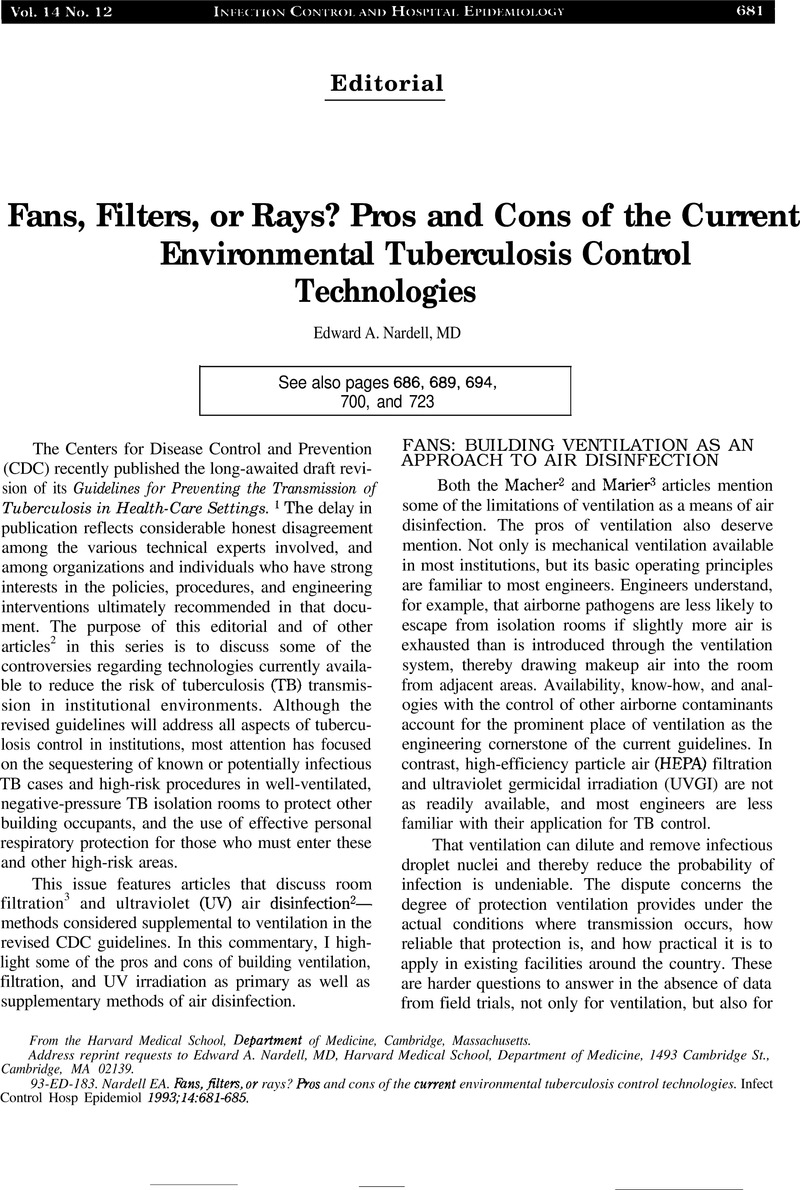No CrossRef data available.
Article contents
Fans, Filters, or Rays? Pros and Cons of the Current Environmental Tuberculosis Control Technologies
Published online by Cambridge University Press: 21 June 2016
Abstract
An abstract is not available for this content so a preview has been provided. As you have access to this content, a full PDF is available via the ‘Save PDF’ action button.

- Type
- Editorial
- Information
- Copyright
- Copyright © The Society for Healthcare Epidemiology of America 1993
References
1.
Centers for Disease Control and Prevention. Guidelines for preventing transmission of tuberculosis in health-care settings, second edition. Notice of comment period. Federal Register October 12,1993;58:52810–52854.Google Scholar
2.
Macher, JM. The use of germicidal lamps to control tuberculosis in healthcare facilities. Infect Control Hosp Epidemiol
1993;14:723–729.CrossRefGoogle ScholarPubMed
3.
Marier, RL, Nelson, T. A ventilation-filtration unit for respiratory isolation. Infect Control Hosp Epidemiol
1993;14:700–705.Google Scholar
4.
Wells, WE
Ratcliie, HL, Crumb, C. On the mechanism of droplet nuclei infection, II: quantitative experimental airborne infection in rabbits, Am Hyg
1948;47:11–28.Google Scholar
5.
Lurie, MB, Heppleston, AG, Abramson, S, Swartz, IB. An evaluation of the method of quantitative airborne infection and its use in the study of the pathogenesis of tuberculosis. Am Rev Tuberc
1950;61:765–797.Google Scholar
6.
Riley, RL, Mills, CC, O'Grady, F, Sultan, LU, Wittstadt, F, Shivpuri, DN. Infectiousness of air from a tuberculosis ward-ultraviolet irradiation of infected air: comparative infectiousness of different patients. Am Rev Respir Dis
1962;84:511–525.Google Scholar
7.
Macher, JM, Alevantis, LE, Chang, Y-L, Liu, K-S. Effects of germicidal lamps on airborne microorganisms in an outpatient waiting room. Appl Occ Hyg
1992;7:505–513.CrossRefGoogle Scholar
8.
Nardell, EA, Keegan, J, Cheney, SA, Etkind, SC. Airborne infection: theoretical limits of protection achievable by building ventilation. Am Rev Respir Dis
1991;144:302–306.CrossRefGoogle ScholarPubMed
9.
Lindberg, I? Improving hospital ventilation systems for tuberculosis control. Plant Technology and Safety Management Series, The Joint Commission on Accreditation of Healthcare Organizations; 1993:19–23.Google Scholar
10.
Riley, RL. Presentation. NIOSH Workshop on Engineering Controls for Preventing Airborne Infections in Workers in Health Care and Related Facilities: July 14-16,1993; Cincinnati, Ohio.Google Scholar
11.
Riley, RL, Knight, M, Middlebrook, G
Ultraviolet susceptibility of BCG and virulent tubercle bacilli. Am Rev Respir Dis
1976;113:413–418.Google Scholar
12.
Riley, RL, Nardell, EA
Clearing the air-the theory and application of ultraviolet air disinfection. Am Rev Respir Dis
1989;139;1286–1294.Google Scholar
13.
Permutt, S. The impact of ultraviolet light on transmission of infection. Presented at the American College of Chest Physicians Consensus Conference: Institutional Infection Control Measures for Tuberculosis in the Era of Multiple Drug Resistance; November 13, 1993; Chicago, Illinois.Google Scholar
14.
Bruls, WAG. Transmission of human epidermis and stratum comeum as a function of thickness in the ultraviolet and visible wavelengths. Photochem Photobiol
1984;40:485–494.CrossRefGoogle Scholar
15.
Sterenborg, HJCM. Evaluation of skin cancer risk resulting from long-term occupational exposure to radiation from ultraviolet lasers in the range from 190 to 400 nm. Photochem Photobiol
1991;54:775–780.Google Scholar
- 10
- Cited by




